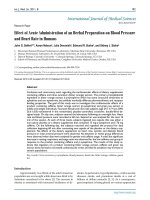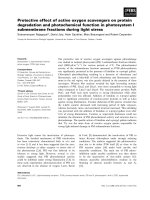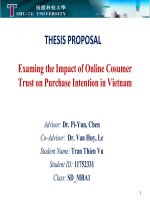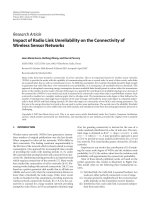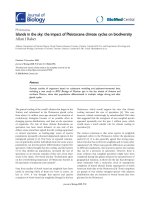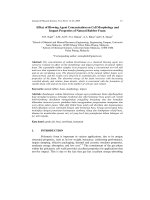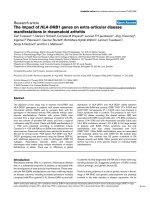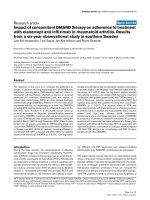Impact of parent–adolescent bonding on school bullying and mental health in Vietnamese cultural setting: Evidence from the global school-based health survey
Bạn đang xem bản rút gọn của tài liệu. Xem và tải ngay bản đầy đủ của tài liệu tại đây (587.89 KB, 10 trang )
Nguyen et al. BMC Psychology
(2019) 7:16
/>
RESEARCH ARTICLE
Open Access
Impact of parent–adolescent bonding on
school bullying and mental health in
Vietnamese cultural setting: evidence from
the global school-based health survey
Hoang Thuy Linh Nguyen1,2, Keiko Nakamura1,3,4* , Kaoruko Seino1,3,4 and Saber Al-Sobaihi1
Abstract
Background: The mental well-being of adolescents is a crucial issue affecting lives of both adults and young
people. Bullying and mental health problems are important factors that can have a negative impact on the mental
well-being of adolescents. Public awareness of mental health problems among adolescents is rapidly growing in
Vietnam. However, current approaches to identifying risk factors influencing mental health problems do not pay
attention to potentially protective factors. This study was performed to examine the associations between parent–
adolescent bonding and mental health outcomes as protective elements during the adolescent period.
Methods: Data collected from 3331 respondents in grade 8–12 as part of the Vietnam Global School-based
Student Health Survey (GSHS) 2013 was used for the analysis. A three-stage cluster sample design was used to
produce data representative of students. Multivariate logistic regression analysis was performed to examine the
association of demographic characteristics and data regarding parent–adolescent bonding associations with status
of mental health problems in adolescents.
Results: Parental understanding, parental monitoring were significantly associated with reduced likelihood of being
bullied and mental health problems (P < 0.05). However, parental control was significantly associated with greater
likelihoods of being physically attacked (adjusted odd ratio (aOR) = 1.36, 95%CI, 1.06, 1.75) and mental health
problems, such as suicidal ideation, and loneliness (aOR = 1.96, 95%CI, 1.49, 2.57, aOR = 2.35, 95%CI, 1.75, 3.15,
respectively), after adjusting for potential confounders.
Conclusions: The study indicated the significant associations between parental understanding, monitoring and
control in a proxy of parent–adolescent bonding and mental well-being during the period of adolescent rebellion.
Thus, parent–adolescent bonding in Southeast Asian cultural context may provide an effective means to promote
the mental well-being of adolescents.
Keywords: Parent–adolescent bonding, School bullying, Mental health problems, Adolescent, Vietnam
* Correspondence:
1
Department of Global Health Entrepreneurship, Division of Public Health,
Graduate School of Tokyo Medical and Dental University, Tokyo 113-8519,
Japan
3
Promotion Committee for Healthy Cities, Tokyo, Japan
Full list of author information is available at the end of the article
© The Author(s). 2019 Open Access This article is distributed under the terms of the Creative Commons Attribution 4.0
International License ( which permits unrestricted use, distribution, and
reproduction in any medium, provided you give appropriate credit to the original author(s) and the source, provide a link to
the Creative Commons license, and indicate if changes were made. The Creative Commons Public Domain Dedication waiver
( applies to the data made available in this article, unless otherwise stated.
Nguyen et al. BMC Psychology
(2019) 7:16
Background
Mental well-being is a fundamental component of the
World Health Organization (WHO) definition of health,
and the core of mental health action with the principle
“no health without mental health” was globally accepted
[1]. The mental well-being of adolescents is a crucial
issue affecting lives of both adults and young people.
Suicide is among the top causes of death among teenagers [2], and the prevalence rates of ever suicidal
ideation and attempted suicide are high among Asian
youths [3] with estimated values of 11.7 and 2.4%, respectively, in six ASEAN member states [3, 4]. Bullying and mental health problems are important
phenomena that can have a negative impact on mental well-being among adolescents.
There is a growing awareness regarding mental health
problems in Vietnam [5, 6]. The Survey Assessment of
Vietnamese Youth (SAVY I, SAVY II) showed that more
than 30% of adolescents self-reported lifestyle experiences of low mood, and the prevalence rates of suicide
behaviors were 5.28% (SAVY I) and 12.21% (SAVY II)
[7]. Poor mental health (anxiety, depression and suicidal
ideation) was shown to be common among adolescents
in a number of provinces in Vietnam [8], and a number
of risk factors were shown to be associated with mental
health problems, including female sex, belonging to an
ethic minority, illiteracy, exposed to violence, stress related to education loans, following a religion other than
Buddhism, and living in a wealthier family [7].
Bullying behaviors is a widespread phenomenon in
childhood and adolescence. The core issues of violence
among adolescents in school magnify concerns about
school bullying, which is not only significant public
health issue but is also a possible determinant of poor
mental well-being among adolescents [9]. Moreover,
studies performed in different countries have indicated
that bullying at school is associated with psychological
distress and suicidal behavior in adolescents [10–13].
The family environment is an important factor related
to mental health problems and school bullying. Parent–
child relations are thought to be important contributors
to children’s growth, and personality development as
well as having important effects on children’s health and
mental well-being [14, 15]. Permissive parents tend to
indulge their children, encourage them to be autonomous in decision making, and rarely punish them for
misbehavior. In contrast, authoritarian parents are strict,
controlling, and consistently punish children for disobedience. Authoritative parents take an intermediate
approach, aiming to have open communication with
their children to understand the consequences of their
behaviors and decisions. A concept of a ‘parent-adolescent bonding’ is considered to be consisted of two dimensions, parental care and parental overprotection
Page 2 of 10
[16]; the latter is characterized by excessive contact and
interference to independent behaviors [17, 18]. Several
studies performed in Western countries and in Asia have
indicated that not only perceived parenting, but also parenting styles as well as parental care, over-control, conflict, and warmth are associated with adolescent mental
health problems [19]. Studies in the USA conducted
among adolescents aged 11–18 years old indicated that
children with positive feelings toward their parents
tended to have good mental health, while those with
negative feelings were more likely to exhibit problem behavior [20]. In traditional Vietnamese culture, the multigenerational interaction plays a more important role in
individuals’ lives, parenting styles draw mostly on Buddhist beliefs, emphasizing the interdependence of the
family, respect for adults, and obedience toward parents
[21]. Vietnam, one of top three countries with high GDP
growth rates among Southeast Asia [22], is experiencing
rapid socio-economical changes in society, such as increased internal migration from rural to urban areas,
changes in family structure, and changes in roles of parents in modernized families [21]. How does the picture
describe the role of parent–child bonding and mental
well-being during the adolescent period in specific context? There has been limited research regarding this
topic in Vietnam.
The present study was performed to identify if parental understanding, parental monitoring, and parental
control in the proxy of parent–adolescent bonding are
associated with (1) school bullying including being bullied, being physical attacked and (2) mental health problems (loneliness and suicide ideation) after adjusting for
potential confounding factors.
Methods
Data source
The present study was performed using the publicly available data obtained as part of the Vietnam Global
School-based Student Health Survey (GSHS) in 2013,
which is available online [23]. The 2013 Vietnam GSHS
used a three-stage cluster sampling design to recruit a nationally representative sample of school students in grades
8–12 in Vietnam. Provinces in the first stage, and schools
in the second stage were selected with probability proportional to enrollment size. At the third stage, all students in
randomly selected classes were eligible for inclusion in the
study. The total sample consisted of 3331 students aged
12–17 years old. Students self-reported their responses to
each question in the GSHS questionnaire and the overall
response rate was 96%.
Survey instruments
The questionnaires developed by the WHO and Centers
for Disease Control and Prevention (CDC) for use in the
Nguyen et al. BMC Psychology
(2019) 7:16
GSHS were used to collect information from school students in grades 8–12. In some previous validation studies, GSHS was reported to have acceptable validity [24].
Page 3 of 10
of friends were mostly supportive always or most of the
time.
Data analysis
Study variables
Four binary outcome variables were measured: (1) having been bullied (2) having been physically attacked (3)
loneliness and (4) suicidal ideation.
School bullying was defined as aggressive behavior by
a student or group of student with a power imbalance
and potential to be repeated. (1) Having been bullied
was identified with the question “How many days were
you bullied during the past 30 days?” and the response
was recoded as “yes” for answer of one or more days or
“no” (2) Having been physically attacked was examined
with the question “How many times were you physically
attacked during the past 12 months?” and was recorded
by “yes” for answer of one or more times or “no”.
Mental health problems among adolescents were defined as feelings of loneliness and suicidal ideation. (3)
The incidence of loneliness was examined using the
question “How often have you felt lonely during the past
12 months?” with responses ranging from “never” to “always.” The responses were dichotomized to “lonely”
meaning most of the time/always or “no” meaning
“never/rarely or sometimes.” (4) Suicidal ideation was
examined with the question “Did you ever seriously consider attempting suicide during the past 12 months?”
with a binary response of “yes” or “no.”
The analysis included a number of independent variables that may influence the likelihood of school bullying
and mental well-being of adolescents: gender (male, female), education level (junior high school, senior high
school), and food insecurity (never/rarely, sometimes,
most of the time/always).
Parental understanding, parental monitoring and parental control are components of a proxy of parent–adolescent bonding [16]. Parental understanding and
parental monitoring were identified via separate questions, i.e., “How often did your parents or guardians
understand your problems and worries during the past
30 days?” and “How often did your parents or guardians
really know what you were doing with your free time
during the past 30 days?” Parental control was examined
with the question “How often did your parents or guardians go through your things without your approval during the past 30 days?” The responses to these questions
were “never,” “rarely,” “sometimes,” “most of the time,”
and “always.” These variables were recoded and classified as “yes,” which included “most of the time/always,”
and “no,” which included “never,” “rarely,” and
“sometimes.”
Relationships with friends were defined as having close
friends and the respondents reported that the majority
In descriptive analysis, categorical variables were summarized using proportions and were then presented in
tables and with significance of differences determined by
Pearson Chi Square test for categorical variables. All
cases which have missing values of selected variables in
the public dataset were excluded, and 2968 subjects were
finally included in the analysis.
Bivariate analysis was then performed to test for associations between the outcome variables. i.e., school
bullying, and mental health problems, and other independent variables.
A multivariate logistic regression model was used to
evaluate associations between outcome variables and risk
factors related to parental understanding, parent monitoring and parental control after adjustment for potential independent variables (gender, education levels, food
insecurity, and relationship with friends). The Hormer
and Lemeshow Goodness-of-Fit Test with P > 0.05 was
used to assess the goodness of fit model. In all analyses,
P < 0.05 was taken to indicate statistical significance.
The data were analyzed using SPSS version 23.0 (SPSS
Inc., Chicago, IL).
Results
A total of 3331 subjects completed the self-reported
questionnaire used in this survey. Overall, 46.9% (n =
1765) of the 3331 adolescents were boys, and there were
no significant differences in gender distribution according to education level. Only 34 of the adolescents (1.0%)
reported food insecurity “most of the time/always,” and
there were no significant differences in rate of food insecurity between junior high school and senior high school
(P > 0.05). The majority of the respondents reported
having close friends (93.0%) that were supportive always/most of the time (51.6%). The percentages of respondents that reported parental understanding of their
problems and parental monitoring of their free time activities were 31.3 and 38.5%, respectively. Parental understanding and monitoring showed significant
differences according to education level (P < 0.05).
Moreover, the percentage of respondents reporting parental control was 14.2% (465 of the total of 3331 adolescents), and the value did not differ significantly
according to education level (P > 0.05) (Table 1).
Table 1 also shows the prevalence rates of being bullied, being physically attacked and mental health problems. The rates of being physically attacked or bullied in
school for one or more days among the respondents
were 23.3 and 22.1%, respectively. Among the study
population, 11.2 and 16.4% reported feeling lonely and
Nguyen et al. BMC Psychology
(2019) 7:16
Page 4 of 10
Table 1 Descriptive statistics by education level among Vietnamese adolescents
Total
Junior high school
n = 3331
n
%
Senior high school
n
%
Male
1557
731
46.3
655
47.2
Female
1765
849
53.7
733
52.8
Missing value
9
P*
Sex
0.615
Food insecurity
Never/Rarely
2593
1265
80.1
1073
77.3
Sometimes
689
302
19.1
300
21.6
Most of the time/Always
34
13
0.8
15
1.1
Missing value
15
1038
532
33.7
390
28.1
No
2283
1048
66.3
998
71.9
Missing value
10
0.173
Parental understanding
‘Parents understood problems’
Yes
0.001
Parental monitoring
‘Parents were aware of free time activities’
Yes
1274
654
41.4
492
35.4
No
2035
926
58.6
896
64.6
Missing value
22
0.001
Parental control
‘Parents went through things without permission’
Yes
465
230
14.6
188
13.5
No
2814
1350
85.4
1200
86.5
Missing value
52
0.429
Supportive friends
Yes
1669
797
50.4
716
51.6
No
1644
783
49.6
48
48.4
Missing value
18
0.535
Close friendships
0
173
53
3.4
97
7.0
≥1
3138
1527
96.6
1291
93.0
Missing value
20
< 0.001
Having been physically attacked
One or more times
734
433
27.4
197
14.2
No
2582
1147
72.6
1191
85.8
Missing value
15
< 0.001
Having been in physical fight
One or more times
576
325
20.6
166
12.0
No
2731
1255
79.4
1222
88.0
Missing value
24
< 0.001
Having been bullied
One or more days
744
420
26.6
255
18.4
No
2456
1160
73.4
1133
81.6
Missing value
131
< 0.001
Nguyen et al. BMC Psychology
(2019) 7:16
Page 5 of 10
Table 1 Descriptive statistics by education level among Vietnamese adolescents (Continued)
Total
Junior high school
n = 3331
n
%
Senior high school
n
%
Yes
367
137
8.7
178
12.8
No
2910
1443
91.3
1210
87.2
Missing value
54
539
215
13.6
258
18.6
No
2750
1365
86.4
1130
81.4
Missing value
42
P*
Mental health
Loneliness
< 0.001
Suicidal ideation
Yes
< 0.001
*Excluding all missing values n = 2968
having thoughts of suicide, respectively, and mental
health problems showed significant differences according
to education level (P < 0.05).
Table 2 shows the results of logistic regression analysis
regarding school bullying (being bullied or being physically attacked) with adolescents’ characteristic, parent–
adolescent bonding, and support of friends. The factors
included in the analysis included education level, parental understanding, parental monitoring, supportive
friends and close friendships, and showed significant relations with likelihood of being bullied (P < 0.05). After
adjusting the confounding variables, adolescents with
parental monitoring their children’s free time activities
had 0.78 times lower rates of being bullied compared to
those without parental monitoring (adjusted odd ratio
(aOR) =0.78, 95%CI, 0.63, 0.95). Moreover, education
level, and supportive friends in school remained significantly associated with rate of being bullied (aOR =1.69,
95%CI, 1.41, 2.03, aOR = 0.64, 95%CI, 0.53, 0.76, respectively) on multivariate logistic regression analysis.
As shown in Table 2, being physically attacked had significant associations with sex, education level, the proxy
of parent-adolescent bonding, and supportive friends in
school (P < 0.05). Multivariate analysis indicated that adolescents with parental monitoring were 0.67 times less
likely to have been physically attacked than those without parental monitoring, while those with parental control were 1.36 times more likely to have been physically
attacked than those without parental control (aOR
=0.67, 95%CI, 0.54, 0.82, aOR =1.36, 95%CI, 1.06, 1.75,
respectively).
Table 3 shows factors suggested to be associated with
mental health problems among Vietnamese adolescents,
which included loneliness and suicidal ideation. Bivariate
analysis indicated significant associations of parental understanding, parental monitoring, and parental control
in a proxy of parent-adolescent bonding with loneliness
and suicidal ideation. Parent-adolescent bonding
remained significant predictors of mental health status
with the addition of potential confounding factors into
the logistic regression model, such as sex, education
level, food insecurity, supportive friends, close friends
and some of variables related to bullying. In particular,
adolescents with parental understanding, parental monitoring had significantly lower rates of suicidal ideation
(aOR =0.61, 95%CI, 0.46, 0.81, aOR =0.52, 95%CI, 0.40,
0.67, respectively) and parental monitoring had significantly lower rates of loneliness (aOR =0.62, 95%CI, 0.46,
0.83) while the rates of suicidal ideation and loneliness were approximately double in adolescents with parental control (aOR =1.96, 95%CI, 1.49, 2.57, aOR =2.35,
95%CI, 1.75, 3.15, respectively).
Discussion
The results of the present study suggest that the parent–
adolescent relationship was associated with mental
health of adolescents. This study also demonstrated association between adolescent mental well-being and gender, education level, and relationships with friends. In
the proxy of parent-adolescent bonding, parental understanding and parental monitoring were significantly associated with reducing the likelihoods of school bullying
and mental health problems, while parental control was
associated with increased rates of being bullied in school
or have mental health problems among adolescents.
The results of this study indicated that school bullying
and mental health problems are important concerns
among school-going adolescents in Vietnam, and being
bullied was related to higher likelihood of mental health
problems, as reported in previous studies [4, 8, 9, 13,
25–28]. There were significant differences in rates of being bullied, being physically attacked, loneliness, and suicidal ideation according to education levels and gender
in this study [26]. School bullying is more common in
Nguyen et al. BMC Psychology
(2019) 7:16
Page 6 of 10
Table 2 Associations between parent–adolescent bonding and bullying/victimization among Vietnamese adolescents
Having been bullied
Having been physically attacked
OR (95%CI)
aOR (95%CI)
OR (95%CI)
aOR (95%CI)
Male
0.92 (0.77, 1.09)
0.92 (0.77, 1.10)
1.85 (1.55, 2.21)***
1.92 (1.60, 2.31) ***
Female
1
1
1
1
Junior high school
1.61 (1.35, 1.92)***
1.69 (1.41, 2.03)***
2.28 (1.89, 2.75)***
2.46 (2.03, 2.98)***
Senior high school
1
1
1
1
Never/Rarely
0.65 (0.29, 1.49)
0.70 (0.30, 1.62)
0.51 (0.23, 1.14)
0.50 (0.22, 1.17)
Sometimes
1.10 (0.48, 2.54)
1.11 (0.47, 2.63)
0.78 (0.35, 1.77)
0.76 (0.32, 1.80)
Most of the time/Always
1
1
1
1
Yes
0.73 (0.60, 0.89)***
0.90 (0.73, 1.11)
0.82 (0.67, 0.99)*
0.95 (0.76, 1.19)
No
1
1
1
1
Sex
Education level
Food insecurity
Parental understanding
‘Parents understood problems’
Parental monitoring
‘Parents were aware of free time activities’
Yes
0.69 (0.58, 0.83)***
0.78 (0.63, 0.95)*
0.65 (0.54, 0.78)***
0.67 (0.54, 0.82)***
No
1
1
1
1
Parental control
‘Parents went through things without permission’
Yes
1.22 (0.96, 1.55)
1.26 (0.99, 1.61)
1.37 (1.08, 1.74)**
1.36 (1.06, 1.75)*
No
1
1
1
1
Yes
0.58 (0.49, 0.70)***
0.64 (0.53, 0.76)***
0.65 (0.54, 0.78)***
0.71 (0.59, 0.86)***
No
1
1
1
1
Yes
0.69 (0.48, 0.99)*
0.74 (0.51, 1.07)
0.81 (0.55, 1.19)
0.86 (0.57, 1.28)
No
1
1
1
1
Supportive friends
Close friendships
* P < 0.05, ** P < 0.01, ***P < 0.001
OR Odds ratio
aOR adjusted odds radio (adjusted for sex, education level, food insecurity, parent-adolescent bonding, supportive friends, close friendship)
CI confidence interval
junior high school compared to senior high school [29].
This may be because senior students have undergone
more physical and psychosocial development than their
younger counterparts, and are therefore better able to
protect themselves [30]. In contrast, younger students
have less likelihood of mental health problems [4].
The school environment and family climate have important roles in promoting school health as it related to
bullying [31]. Parental understanding and parental monitoring were shown here to be related to a lower likelihood of adolescent being bullied or being physically
attacked. Parental interest in their children’s free time
activities and problems has a protective effect against
bullying in school from student’s point of view. Socioeconomic changes also affect parental care, as modern
parents are often busy with work and sometimes do not
know about their children’s problems during adolescent
development. The result presented here indicated that a
high level of parental concern has a positive association
to their adolescent children.
The association between of parent–adolescent bonding
and mental well-being observed in this study was consistent with previous research [19, 32, 33]. Although
modern trends emphasize adolescents’ competence and
needs for independence, parents may be certain that
their involvement in the lives of their adolescent children promotes mental health [33]. Moreover, a strong
respect for their elders is inculcated in children in cultural context of most Southeast Asian countries, including Vietnam. In particular, communication between
Nguyen et al. BMC Psychology
(2019) 7:16
Page 7 of 10
Table 3 Association between parent-adolescent bonding and mental health among Vietnamese adolescents
Suicidal ideation
Loneliness
OR (95%CI)
aOR (95%CI)
OR (95%CI)
aOR (95%CI)
Male
0.51 (0.41, 0.62) ***
0.42 (0.34, 0.53)***
0.79 (0.63, 1.01)
0.71 (0.55, 0.92)*
Female
1
1
1
1
Junior high school
0.69 (0.57, 0.84) ***
0.67 (0.54, 0.83)***
0.65 (0.51, 0.82)***
0.63 (0.49, 0.81)***
Senior high school
1
1
1
1
Never/Rarely
0.62 (0.25, 1.54)
0.82 (0.31, 2.15)
0.49 (0.18, 1.30)
0.68 (0.24, 1.92)
Sometimes
1.00 (0.40, 2.52)
1.04 (0.39, 2.76)
0.76 (0.28, 2.04)
0.84 (0.29, 2.40)
Most of the time/Always
1
1
1
1
Yes
0.41 (0.32, 0.53) ***
0.61 (0.46, 0.81)***
0.58 (0.44, 0.77)***
0.81 (0.58, 1.10)
No
1
1
1
1
Sex
Education Level
Food insecurity
Parental understanding
‘Parents understood problems’
Parental monitoring
‘Parents were aware of free time activities’
Yes
0.39 (0.31, 0.50) ***
0.52 (0.40, 0.67)***
0.51 (0.39, 0.66)***
0.62 (0.46, 0.83)***
No
1
1
1
1
Parental control
‘Parents went through things without permission’
Yes
1.75 (1.36, 2.25)***
1.96 (1.49, 2.57)***
2.29 (1.73, 3.02)***
2.35 (1.75, 3.15)***
No
1
1
1
1
Yes
0.66 (0.54, 0.80)***
0.84 (0.68, 1.04)
0.71 (0.56, 0.90)*
0.88 (0.68, 1.13)
No
1
1
1
1
Yes
0.33 (0.23, 0.47)***
0.41 (0.28, 0.60)***
0.24 (0.17, 0.35)***
0.31 (0.21, 0.45)***
No
1
1
1
1
Yes
1.47 (1.18, 1.85) ***
1.06 (0.79, 1.41)
1.48 (1.14, 1.93)**
0.99 (0.71, 1.39)
No
1
1
1
1
Yes
1.84 (1.45, 2.33)***
2.02 (1.50, 2.72)***
1.72 (1.30, 2.27)***
1.53 (1.09, 2.15)*
No
1
1
1
1
Yes
1.72 (1.39, 2.14)***
1.29 (1.01, 1.66)*
2.11 (1.65, 2.71)***
1.80 (1.35, 2.38)***
No
1
1
1
1
Supportive friends
Close friendships
Having been physically attacked
Having been in physical fight
Having been bullied
* P < 0.05, ** P < 0.01, ***P < 0.001
OR Odds ratio
aOR adjusted odds radio (adjusted for sex, education level, food insecurity, parent-adolescent bonding, supportive friends, close friendships, having been
physically attacked, having been in physical fight, having been bullied)
CI confidence interval
parents and adolescents is based on respectful conversation about family roles, relationships, and other social issues. As noted above, Southeast Asian culture generally
emphasizes respect for authority. Southeast Asian
parents are more restrictive and more control-oriented
than their European and American counterparts, and
they tend to use more commands and attempt to directly control their children’s attention [34]. With regard
Nguyen et al. BMC Psychology
(2019) 7:16
to the findings of this study, it is therefore noteworthy
that parental understanding and monitoring seem to
play a protective role in improving mental well-being,
while parental control is a risk factor for increasing
mental health problems during the adolescent period.
These results are consistent with previous findings indicating that a high level of parental involvement is related
to reduce likelihood of poor mental health among adolescents [19, 35], while a lack of parental warmth and high
maternal over-control are associated with a wide range of
psychological problems, including depression, suicidal behavior, and self-harm among adolescents [36–38].
In this observational study, directions of relationship
between parental-adolescent bonding and mental health
among adolescence can be interpreted in both ways [39].
One is a pathway from the characteristics of parental
bonding influence to adolescents’ mental health presented by a multivariable logistic regression model.
However, the inference of the potential reverse association
is still possible. An example of alternative causal inference
is that antisocial behavior of children increases monitoring
by parents. Future research is required to address the
causal pathway with quasi-experimental designs [39].
Adolescence is a time characterized by significant
rapid neurological, cognitive and social changes for the
integration of new and diverse experiences in relation to
the world and themselves. Adolescence also presents the
dilemma of maintaining a connection with parents while
exploring new social roles away from the family and developing relationships with peers [40]. Rapid economic
growth together with a lack of social infrastructure support resulted in increased pressure on families, threatening their traditional ability to socialize children into
adaptively functioning adults [41, 42], therefore, parental–adolescents bonding may play critical role in leading
children in the next level of social functioning [40]. Public health initiatives encouraging parents to maintain a
connection with their adolescents are considered to help
alter the general impression, and even the context of
adolescent disinterest and rebellion [40].
The present study was performed using data collected
by the WHO and CDC with a standardized questionnaire
and methods, with a nationally representative sample size,
and an appropriate sampling method. However, the study
had several limitations. First, the cross-sectional survey
could not make causal inferences. Second, as with many
earlier studies in this areas, the outcome variables of this
study (having been bullied, having been physically
attacked, loneliness, and suicidal ideation) also the predictor related to proxy of parent-adolescents bonding
were assessed with a single item question instead of a
multi- items scale such as: instrument used in public
health for depression by The Center for Epidemiological
Studies-Depression Scale (CES-D) with 20 self-reported
Page 8 of 10
items; or Parental Bonding Instrument (PBI) consisting of
25 items, which could reduce validity and reliability.
Therefore, the further validation measurement of this
topic in Vietnam context may be required. Third, mental
health measurements were dependent on the variables
used in the GSHS survey in Vietnam. Therefore, single
item was used for evaluation of adolescent-parent bonding
instead of multi-items scale, and several adolescent mental
health issues (depression, insomnia, and self-harm) were
not evaluated. Finally, the results may have been affected
by recall bias, due to use of self-reported responses.
Conclusions
The results of this study indicated that the parent–adolescent connection had a significant association with
mental well-being during the adolescent period. Parental
understanding and parental monitoring in a proxy of
parent-adolescent bonding have associated factors increased mental well-being of young people, while parental control was a risk factors during the period of
adolescent rebellion. These findings suggest that focusing of the parent–adolescent connection in Southeast
Asian cultural context may provide an effective means
to promote mental well-being among adolescents. Further, Vietnamese parents should also participate in psychological education programs to raise awareness of
how certain types of interactions with young people may
represent strategies for reducing mental health problems
and promoting a healthy school environment.
Abbreviations
CDC: Centers for Disease Control and Prevention; GSHS: Global School-based
Student Health Survey; SAVY: Survey Assessment of Vietnamese Youth;
WHO: World Health Organization
Acknowledgments
We are grateful to the World Health Organization and the Centers for
Disease Control and Prevention for making their data publicly available. We
appreciate the efforts of Vietnam for collecting the Global School-based Student Health Survey data. We thank all participating schools, students, and
other organizations contributed to data collection.
Funding
This work is partly supported by Japanese Society for Promotion of Science
Grant (17H02164).
Availability of data and materials
The dataset used for this analysis was generated from the original Vietnam
GSHS datasets available in the Global school-based student health survey
(GSHS) />Authors’ contributions
HTLN originated the design of the study, performed statistical analysis,
interpretation, and drafted the manuscript. KN contributed to the design of
the study, conceptualization, and the interpretation data. HTLN, KN, KS and
SA critically revised the draft manuscript. All authors have read and approved
the final manuscript.
Ethics approval and consent to participate
The original survey was approved by the Ethics Committees of the WHO and
the US Centers for Disease Control (CDC), and by the Ministry of Health,
Vietnam. This study was based on analysis of existing public data that are
Nguyen et al. BMC Psychology
(2019) 7:16
freely available online with all identifier information detached. Permission to
access Vietnam dataset was granted thorough GSHS project.
Consent for publication
Not applicable.
Competing interests
The authors declare that they have no competing interests.
Publisher’s Note
Springer Nature remains neutral with regard to jurisdictional claims in
published maps and institutional affiliations.
Author details
1
Department of Global Health Entrepreneurship, Division of Public Health,
Graduate School of Tokyo Medical and Dental University, Tokyo 113-8519,
Japan. 2Faculty of Public Health, Hue University of Medicine and Pharmacy,
Hue University, Hue, Vietnam. 3Promotion Committee for Healthy Cities,
Tokyo, Japan. 4WHO Collaborating Centre for Healthy Cities and Urban Policy
Research, Tokyo, Japan.
Received: 31 May 2018 Accepted: 10 March 2019
References
1. World Health Organization. Mental health action plan 2013–2020 2013.
Available from: />plan/en/. Accessed 20 June 2018.
2. Cash SJ, Bridge JA. Epidemiology of youth suicide and suicidal behavior.
Curr Opin Pediatr. 2009;21(5):613–9.
3. Blum R, Sudhinaraset M, Emerson MR. Youth at risk: suicidal thoughts and
attempts in Vietnam, China, and Taiwan. J Adolesc Health. 2012;50(3):
S37–44.
4. Peltzer K, Yi S, Pengpid S. Suicidal behaviors and associated factors among
university students in six countries in the Association of Southeast Asian
Nations (ASEAN). Asian J Psychiatr. 2017;26:32–8.
5. Nguyen DT, Dedding C, Pham TT, Bunders J. Perspectives of pupils, parents,
and teachers on mental health problems among Vietnamese secondary
school pupils. BMC Public Health. 2013;13:1046.
6. Weiss B, Dang M, Trung L, Nguyen MC, Thuy NTH, Pollack A. A NationallyRepresentative Epidemiological and Risk factor assessment of child mental
health in Vietnam. Int Perspect Psychol. 2014;3(3):139–53.
7. Le MTH, Nguyen HT, Tran TD, Fisher JRW. Experience of low mood and
suicidal behaviors among adolescents in Vietnam: findings from two
National Population-Based Surveys. J Adolesc Health. 2012;51(4):339–48.
8. Nguyen DT, Dedding C, Pham TT, Wright P, Bunders J. Depression, anxiety,
and suicidal ideation among Vietnamese secondary school students and
proposed solutions: a cross-sectional study. BMC Public Health. 2013;13:
1195.
9. Cosma A, Whitehead R, Neville F, Currie D, Inchley J. Trends in bullying
victimization in Scottish adolescents 1994–2014: changing associations with
mental well-being. Int J Public Health. 2017;62(6):639–46.
10. Schneider SK, O'Donnell L, Stueve A, Coulter RWS. Cyberbullying, school
bullying, and psychological distress: a regional census of high school
students. Am J Public Health. 2012;102(1):171–7.
11. Page RM, Yanagishita J, Suwanteerangkul J, Zarco EP, Mei-Lee C, Miao N-F.
Hopelessness and loneliness among suicide attempters in school-based
samples of Taiwanese, Philippine and Thai adolescents. Sch Psychol Int.
2006;27(5):583–98.
12. Kaltiala-Heino R, RimpelÄ M, Rantanen P, RimpelÄ A. Bullying at school—an
indicator of adolescents at risk for mental disorders. J Adolesc. 2000;23(6):
661–74.
13. Sampasa-Kanyinga H, Roumeliotis P, Xu H. Associations between
cyberbullying and school bullying victimization and suicidal ideation, plans
and attempts among Canadian schoolchildren. PLoS One. 2014;9(7):
e102145.
14. Dwairy M, Achoui M. Adolescents-family connectedness: a first cross-cultural
research on parenting and psychological adjustment of children. J Child
Fam Stud. 2010;19(1):8–15.
Page 9 of 10
15. Levin KA, Dallago L, Currie C. The association between adolescent life
satisfaction, family structure, family affluence and gender differences in
parent–child communication. Soc Indic Res. 2012;106(2):287–305.
16. Parker G, Tupling H, Brown LB. A parental bonding instrument. Br J Med
Psychol. 1979;52(1):1–10.
17. Thomasgard M, Metz WP. Parental overprotection revisited. Child Psychiatry
Hum Dev. 1993;24(2):67–80.
18. Levy DM. The concept of maternal overprotection. In: Anthony EJ, Benedek
T, editors. Parenthood: its psychology and psychopathology. Boston: Little
Brown; 1970. p. 387–409.
19. Tammariello AE, Gallahue NK, Ellard KA, Woldesemait N, Jacobsen KH.
Parental involvement and mental health among Thai adolescents. Adv
School Ment Health Promot. 2012;5(4):236–45.
20. Phares V, Renk K. Perceptions of parents: a measure of Adolescents' feelings
about their parents. J Marriage Fam. 1998;60(3):646–59.
21. Mestechkina T, Duc Son N, Shin J. Parenting in Vietnam. In: Selin H, editor.
Parenting across cultures: childrearing, motherhood and fatherhood in nonWestern cultures: Springer; 2014. p. 47–57. />22. World Bank. GDP growth (annual %). World Bank national accounts data,
and OECD National Accounts data files. 2017. Available from: https://data.
worldbank.org/indicator/NY.GDP.MKTP.KD.ZG?end=2017&locations=VN-KHID-LA-TH-MY-MM-PH-TL-SG&name_desc=true&start=2017&view=bar.
Accessed 15 February 2019.
23. World Health Organization. Global school-based student health survey
(GSHS) 2013. Available from: />Accessed 10 August 2017.
24. Becker AE, Roberts AL, Perloe A, Bainivualiku A, Richards LK, Gilman SE, et al.
Youth health risk behavior assessment in Fiji: the reliability of global schoolbased health survey content adapted for ethnic Fijian girls. Ethn Health.
2010;15(2):181–97.
25. Chui WH, Chan HC. Association between self-control and school bullying
behaviors among Macanese adolescents. Child Abuse Negl. 2013;37(4):237–42.
26. Sharma B, Lee TH, Nam EW. Loneliness, insomnia and suicidal behavior
among school-going adolescents in Western Pacific Island countries: role of
violence and injury. Int J Environ Res Public Health. 2017;14(7):791.
27. Randall JR, Doku D, Wilson ML, Peltzer K. Suicidal behaviour and related risk
factors among school-aged youth in the Republic of Benin. PLoS One. 2014;
9(2):e88233.
28. Przybylski AK, Bowes L. Cyberbullying and adolescent well-being in England:
a population-based cross-sectional study. Lancet Child Adolesc Health. 2017;
1(1):19–26.
29. Peyton RP, Ranasinghe S, Jacobsen KH. Injuries, violence, and bullying
among middle school students in Oman. Oman Med J. 2017;32(2):98–105.
30. Huang H, Hong JS, Espelage DL. Understanding factors associated with
bullying and peer victimization in Chinese schools within ecological
contexts. J Child Fam Stud. 2013;22(7):881–92.
31. Bowes L, Arseneault L, Maughan B, Taylor A, Caspi A, Moffitt TE. School,
neighborhood, and family factors are associated with Children's bullying
involvement: a Nationally Representative longitudinal study. J Am Acad
Child Adolesc Psychiatry. 2009;48(5):545–53.
32. Law BMF, Shek DTL. Self-harm and suicide attempts among young Chinese
adolescents in Hong Kong: prevalence, correlates, and changes. J Pediatr
Adolesc Gynecol. 2013;26(3):S26–32.
33. Fröjd S, Kaltiala-Heino R, Rimpelä M. The association of parental monitoring
and family structure with diverse maladjustment outcomes in middle
adolescent boys and girls. Nord J Psychiatry. 2007;61(4):296–303.
34. Russell ST, Crockett LJ, Chao RK. Introduction: Asian American parenting and
parent-adolescent relationships. In: Russell ST, Crockett LJ, Chao RK, editors.
Asian American parenting and parent-adolescent relationships. New York,
NY: Springer New York; 2010. p. 1–15.
35. Hasumi T, Ahsan F, Couper CM, Aguayo JL, Jacobsen KH. Parental
involvement and mental well-being of Indian adolescents. Indian Pediatr.
2012;49(11):915–8.
36. Burbach DJ, Kashani JH, Rosenberg TK. Parental bonding and depressive
disorders in adolescents. J Child Psychol Psychiatry. 1989;30(3):417–29.
37. Lai KW, McBride-Chang C. Suicidal ideation, parenting style, and family
climate among Hong Kong adolescents. Int J Psychol. 2001;36(2):81–7.
38. Klemera E, Brooks FM, Chester KL, Magnusson J, Spencer N. Self-harm in
adolescence: protective health assets in the family, school and community.
Int J Public Health. 2017;62(6):631–8.
Nguyen et al. BMC Psychology
(2019) 7:16
39. Jaffee SR, Strait LB, Odgers CL. From correlates to causes: can quasi-experimental
studies and statistical innovations bring us closer to identifying the causes of
antisocial behavior? Psychol Bull. 2012;138(2):272–95.
40. Moretti MM, Peled M. Adolescent-parent attachment: bonds that support
healthy development. Paediatr Child Health. 2004;9(8):551–5.
41. Gabriele A. Social services policies in a developing market economy
oriented towards socialism: the case of health system reforms in Vietnam.
Rev Int Polit Econ. 2006;13(2):258–89.
42. Ruiz-Casares M, Heymann J. Children home alone unsupervised: modeling
parental decisions and associated factors in Botswana, Mexico, and Vietnam.
Child Abuse Negl. 2009;33(5):312–23.
Page 10 of 10
